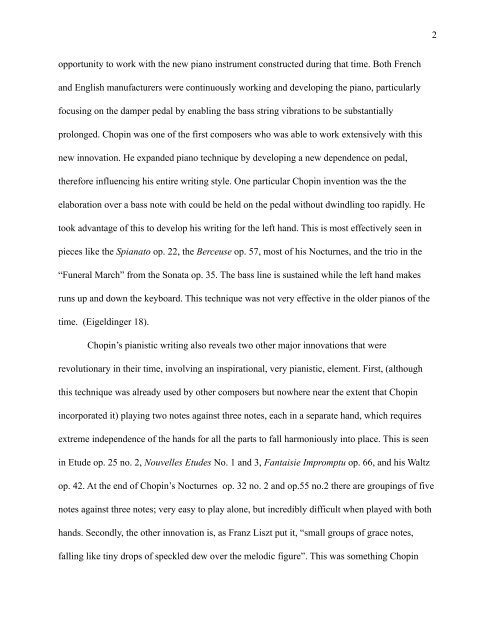Click here for the (pdf) - Michael Kravchuk
Click here for the (pdf) - Michael Kravchuk
Click here for the (pdf) - Michael Kravchuk
Create successful ePaper yourself
Turn your PDF publications into a flip-book with our unique Google optimized e-Paper software.
opportunity to work with <strong>the</strong> new piano instrument constructed during that time. Both French<br />
and English manufacturers were continuously working and developing <strong>the</strong> piano, particularly<br />
focusing on <strong>the</strong> damper pedal by enabling <strong>the</strong> bass string vibrations to be substantially<br />
prolonged. Chopin was one of <strong>the</strong> first composers who was able to work extensively with this<br />
new innovation. He expanded piano technique by developing a new dependence on pedal,<br />
t<strong>here</strong><strong>for</strong>e influencing his entire writing style. One particular Chopin invention was <strong>the</strong> <strong>the</strong><br />
elaboration over a bass note with could be held on <strong>the</strong> pedal without dwindling too rapidly. He<br />
took advantage of this to develop his writing <strong>for</strong> <strong>the</strong> left hand. This is most effectively seen in<br />
pieces like <strong>the</strong> Spianato op. 22, <strong>the</strong> Berceuse op. 57, most of his Nocturnes, and <strong>the</strong> trio in <strong>the</strong><br />
“Funeral March” from <strong>the</strong> Sonata op. 35. The bass line is sustained while <strong>the</strong> left hand makes<br />
runs up and down <strong>the</strong> keyboard. This technique was not very effective in <strong>the</strong> older pianos of <strong>the</strong><br />
time. (Eigeldinger 18).<br />
Chopin’s pianistic writing also reveals two o<strong>the</strong>r major innovations that were<br />
revolutionary in <strong>the</strong>ir time, involving an inspirational, very pianistic, element. First, (although<br />
this technique was already used by o<strong>the</strong>r composers but now<strong>here</strong> near <strong>the</strong> extent that Chopin<br />
incorporated it) playing two notes against three notes, each in a separate hand, which requires<br />
extreme independence of <strong>the</strong> hands <strong>for</strong> all <strong>the</strong> parts to fall harmoniously into place. This is seen<br />
in Etude op. 25 no. 2, Nouvelles Etudes No. 1 and 3, Fantaisie Impromptu op. 66, and his Waltz<br />
op. 42. At <strong>the</strong> end of Chopin’s Nocturnes op. 32 no. 2 and op.55 no.2 t<strong>here</strong> are groupings of five<br />
notes against three notes; very easy to play alone, but incredibly difficult when played with both<br />
hands. Secondly, <strong>the</strong> o<strong>the</strong>r innovation is, as Franz Liszt put it, “small groups of grace notes,<br />
falling like tiny drops of speckled dew over <strong>the</strong> melodic figure”. This was something Chopin<br />
2


